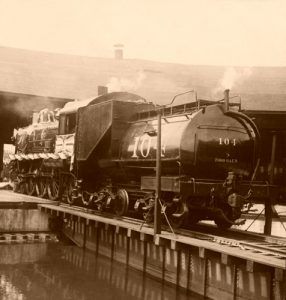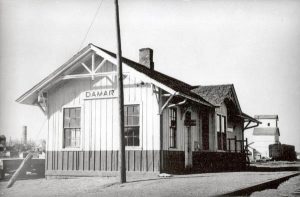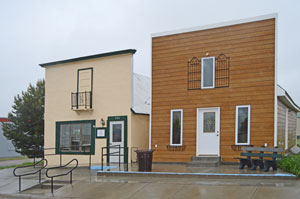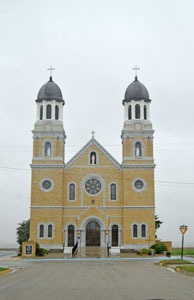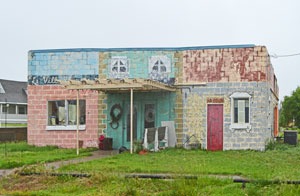
Welcome to Damar, Kansas, by Kathy Alexander.
Damar, Kansas, is a very small town in west-central Rooks County.
Damar was established along the Union Pacific Railroad in 1888 by a community of French Canadians. Some had emigrated from Canada as early as 1871, settling on farms along the Rooks County-Graham County line in northwest Kansas.
Many people of French Canadian origin who immigrated to Damar, Kansas, came directly from Quebec, Canada, or by way of Kankakee, Illinois, beginning in the late 1870s. One of the original settlers was John Baptiste Hubert and his wife Josephine, who came from Illinois and lived in a sod house about 1/2 mile from president day Damar. However, though they tried to farm for seven years, drought, heat, wind, and grasshoppers devastated their crops. They finally held a farm sale and returned to Illinois.
Joe St. Peter and his family were among the first French Canadians to arrive in the area in 1877. He and his wife Ezra homesteaded a farm a few miles from present-day Damar. Soon, several French Canadian families followed in covered wagons drawn by oxen. The settlement was first called St. Petersville. Another family who settled early on was Francois Saint Pierre and his wife, Euphrosine. They settled on a quarter section of land 2.5 miles southwest of Damar in 1878 and lived in a dugout. Soon, many others followed, and the area developed a solid French Canadian character and was referred to as the “Acadia of the West.” Many area descendants still carry on the family names of the first settlers.
In the 1880s, the Union Pacific Railroad began constructing a line through the area about two miles northeast of Petersville on land that became the community of Damar. According to tradition, the community was named after D. M. Marr, the original owner of the townsite. The rail line ran from Salina to Colby. In 1884, Francis St. Peter acquired 160 acres near the railroad under the Homestead Act.
French missionary priest Father Molier celebrated the first Catholic mass in the Pierre dugout in 1887. Church services were also held in the home of Ezra St. Peter. Mr. St. Peter then donated three acres for a cemetery and two acres for a church east of his home. A small wooden church building measuring 16’x32′ was then built.
However, when the railroad began running through nearby Damar in 1888, people and businesses began to move to the new site. The small church in Petersville was soon moved near the railroad, and the nearby Enfield Post Office was relocated to Damar on February 5, 1894. Damar quickly grew in population, and before long, the town boasted a bank, two grocery stores, three taverns, a creamery, a hotel, and three restaurants.
By 1898, the congregation had outgrown the small church. A larger wooden church measuring 60′ x 32′ was built in Damar near the limestone church. The small wooden framed church was then moved by mule-drawn wagons and attached to the back of the new church. The older structure was then utilized as the resident priest’s sanctuary, sacristy, and kitchen.
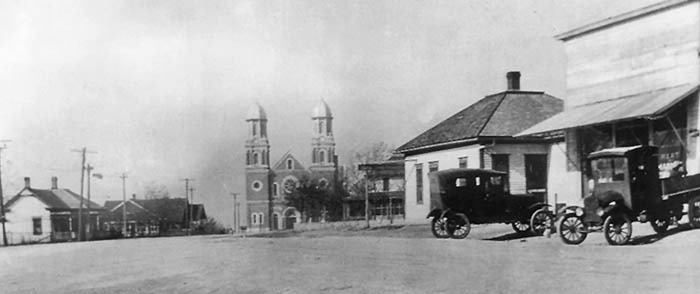
Vintage Damar, Kansas.
By 1910, Damar was described as “one of the thriving towns of Rooks County,” with a money order post office with one rural route, express and telegraph offices, telephone connections, a Catholic church, and a convent. He was the principal shipping point for the western part of the county.
The Topeka State Journal of July 27, 1910, said:
“Five years ago, there were less than half a dozen buildings on the Damar townsite. Today, it has a thrifty population of about 300; it has two general stores, a lumber yard, a bank, hardware and implements, two elevators, a drug store, furniture, and several smaller places. The deposits in the state bank reach close to the $50,000 mark.”
In 1912, the present St. Joseph Catholic Church began to be built. The beautiful Romanesque Revival Church was built of native limestone quarried near Waldo. Twenty train carloads were required for the outside walls, all cut by hand to fit the appropriate sizes required. Two horses were tied to a rope pulley to haul stone and cement to the higher reaches of the building. The parishioners donated their labor to the project, reducing construction costs and making it feasible at an estimated cost of $30,000. The towers were completed in 1913, and the first mass was celebrated in 1917. The old structures were demolished following the completion of the new stone church.
All masses were given in French, the language of Damar residents, until 1923, when the bishop and new Priest, Father Diss, declared that all masses would be spoken in English. Though additional changes were made over the years, it still retains much of its work and design. Recognized as one of the most beautiful churches in the area, the building was listed on the National Historic Register in 2005.
In 1920, Damar had three elevators, two implement dealerships, a hardware store, a lumber yard, a dry goods store, grocery stores, a barbershop, a bank, and an opera hall.
In 1935, it was incorporated, but it didn’t grow much. Its population peaked at 361 in 1960.
In 1874, the Damar High School was unified with Palco High School, but the town still retains an elementary school. The railroad was abandoned in the 1990s.
Today, the town’s population is only about 125, but its French Canadian heritage is reflected in many of the buildings throughout the town. Its Main Street features a cafe, beauty salon, gift shop, bar, and the “French Quarter” Visitor’s Center.
Damar is located about 20 miles southwest of Stockton, the county seat.
More Information:
City of Damar
208 Main Street
Damar, KS 67632
785-839-4445
©Kathy Alexander/Legends of Kansas, updated March 2024.
Also See:
Sources:
Solomon Valley Highway 24 Heritage Alliance
St. Joseph Catholic Church National Register Nomination
Wikipedia

